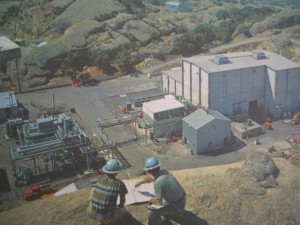 Questionable new EPA soil survey detects radiation thousands of times over cleanup triggers
Questionable new EPA soil survey detects radiation thousands of times over cleanup triggers
By Michael Collins
Ventura County Reporter – March 22, 2012
More than half a century since several partial meltdowns at the former Rocketdyne complex in eastern Ventura County, astronomical amounts of radiation are still being unearthed at the site, according to a new U.S. Environmental Protection Agency PowerPoint dated Feb. 22.
The presentation shows current radiation readings at the now-demolished Sodium Reactor Experiment, or SRE, at levels thousands of times above background. Background means background radiation or the radiation one would expect to find “naturally” from cosmic rays, the sun and radiation in soil and rocks, like uranium, thorium, radium and potassium.
The SRE was the site of an uncontained partial meltdown in 1959 that released hundreds of times more radiation into the environment than the Three Mile Island meltdown did 20 years later.
“This confirms what we were worried about,” said Assemblywoman Julia Brownley, D-Oak Park, a longtime leader in the fight to clean up the 2,850-acre Santa Susana Field Laboratory (SSFL) 30 miles northwest of downtown Los Angeles. “This begins to answer critical questions about what’s still up there, where, how much, and how bad?”
See the U.S. EPA background report & presentation that government officials tried to keep from the media and check out photos and videos of partial meltdown of the Sodium Reactor Experiment.
Brownley expressed disappointment that the site had been supposedly cleaned up twice before by lab owner Boeing and the Department of Energy, which controls Area IV where all of Rocketdyne’s nuclear work was conducted. Partial meltdowns occurred there in at least two other reactors in 1964 and 1969.
“Data show exceedance levels ran as high as 1,000 times the ‘radiation trigger levels’ (RTLs) agreed to by the Department of Energy and the California Department of Toxic Substances Control in a historic cleanup agreement signed in December 2010,” Brownley said, referring to agreements on consent with the DOE and NASA to clean up Rocketdyne to background levels of radiological and chemical contamination. “I call again on the Department of Energy to comply with the agreement that it signed, fully and unconditionally.”
That may be easier said than done. This latest U.S. EPA information appears to redefine what cleaning up to background actually is. Publicly available documents show that the levels of radiation in this part of Area IV where the SRE once stood are actually many thousands of times more contaminated than previously thought.
Just as troubling, the EPA’s RTLs, which are supposed to mirror the extensively tested and reported-on backgrounds of the numerous radionuclides at the site, were many times over the background threshold values (BTVs). So instead of cleaning up to background, much more radiation would be left in the ground, saving the government and lab owner Boeing millions in cleanup.
It is a classic bait and switch. And it almost worked.
It went unnoticed until this reporter spotted the huge discrepancy between the RTLs and BTVs because they were so obvious to anyone with any SSFL knowledge. Yet nobody else had noticed except, obviously, the EPA that created the PowerPoint with the bait-and-switched numbers in the first place.
One soil sample was laced with cesium-137 clocking in at 9,328 times its background, as shown in a July 2011 U.S. EPA Radiological Background Study Report for Rocketdyne in Table 8.4. Yet the EPA’s RTL in the PowerPoint is more than 25 times the same agency’s 2011 background study for subsurface samples of Cs-137, a cancer-causing radionuclide.
On a scenic bluff overlooking Simi Valley next to where the SRE once stood, leukemia-causing strontium-90 was assigned an RTL 6.47 times Sr-90’s BTV and tested at 284 times background.
Strontium-90’s RTL was more than 37 times its BTV in another sample. The hot dirt came in at more than 71 times background radiation, dug out a couple of feet below the surface. This suggests that even after two “cleanups” the area may still be facing a huge excavation job.
See the U.S. EPA background report & presentation that government officials tried to keep from the media and check out photos and videos of partial meltdown of the Sodium Reactor Experiment.
Fuzzy math also made its mark on the RTLs of tritium, carbon-14, cobalt-60, neptunium-239 and europa-152. All were detected by EPA at several multiples of their actual backgrounds.
Nothing could be more worrisome than the manipulation of the levels determined for plutonium-239/240. The isotope is one of the most potent radioactive killers on the planet, yet the EPA’s radiological trigger level was nearly 20 times its background. Exposure to even minute amounts of Pu-239/240 can give a person lung cancer.
Misleading and factually incorrect numbers not only reduce the radiation readings of overages at Rocketdyne, their use could lead to leaving large amounts of radiation in place once the cleanup, which has cost hundreds of millions, ends as soon as 2017.
An EPA official told the Reporter in a March 10 e-mail that he would look into the issue.
The agreements on consent, or AOCs, with DOE and NASA explicitly say that contaminated soils must be removed, not left in place or buried. Yet with these huge radiation readings and markedly lower cleanup standards that violate the agreements, the hot zone that is Rocketdyne just got a whole lot hotter.
25 Years of Award-Winning SSFL/Rocketdyne Reporting
1998 – 2023












Recent Comments